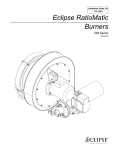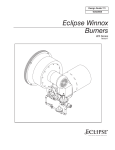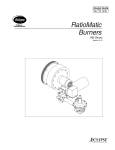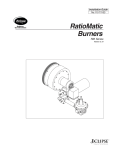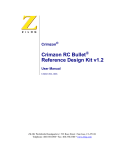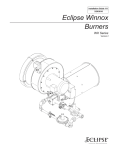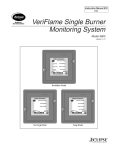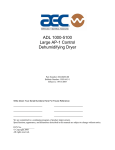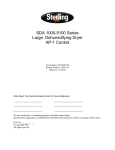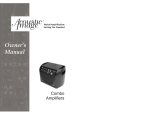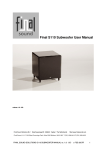Download Eclipse RatioMatic RM Series Datasheet
Transcript
Design Guide 110
11/11/2011
Eclipse RatioMatic
Burners
RM Series
Version 5
Copyright
consequential, including but not limited to loss of use,
income, or damage to material arising in connection with
the sale, installation, use of, inability to use or the repair or
replacement of Eclipse’s products.
Copyright 2010 by Eclipse, Inc. All rights reserved
worldwide. This publication is protected by federal
regulation and shall not be copied, distributed,
transmitted, transcribed or translated into any human or
computer language, in any form or by any means, to any
third parties, without the express written consent of
Eclipse, Inc.
Any operation expressly prohibited in this manual, any
adjustment, or any assembly procedures not
recommended or authorized in these instructions shall
void the warranty.
Disclaimer Notice
Document Conventions
In accordance with the manufacturer’s policy of continual
product improvement, the product presented in this
brochure is subject to change without notice or obligation.
There are several special symbols in this document. You
must know their meaning and importance.
The material in this manual is believed adequate for the
intended use of the product. If the product is used for
purposes other than those specified herein, confirmation
of validity and suitability must be obtained. Eclipse
warrants that the product itself does not infringe upon any
United States patents. No further warranty is expressed or
implied.
Liability & Warranty
We have made every effort to make this manual as
accurate and complete as possible. Should you find errors
or omissions, please bring them to our attention so that we
may correct them. In this way we hope to improve our
product documentation for the benefit of our customers.
Please send your corrections and comments to our
Marketing Communications Manager.
It must be understood that Eclipse’s liability for its product,
whether due to breach of warranty, negligence, strict
liability, or otherwise is limited to the furnishing of
replacement parts. Eclipse will not be liable for any other
injury, loss, damage or expenses, whether direct or
The explanation of these symbols follows below. Please
read it thoroughly.
How To Get Help
If you need help, contact your local Eclipse representative.
You can also contact Eclipse at:
1665 Elmwood Rd.
Rockford, Illinois 61103 U.S.A.
Phone: 815-877-3031
Fax: 815-877-3336
http://www.eclipsenet.com
Please have the information on the product label available
when contacting the factory so we may better serve you.
www.eclipsenet.com
Product Name
Item #
S/N
DD MMM YYYY
This is the safety alert symbol. It is used to alert you to potential personal
injury hazards. Obey all safety messages that follow this symbol to avoid
possible injury or death.
Indicates a hazardous situation which, if not avoided, will result in death
or serious injury.
WARNING
Indicates a hazardous situation which, if not avoided, could result in
death or serious injury.
CAUTION
Indicates a hazardous situation which, if not avoided, could result in
minor or moderate injury.
NOTICE
NOTE
2
Is used to address practices not related to personal injury.
Indicates an important part of text. Read thoroughly.
Table of Contents
Introduction .............................................................................................. 4
Product Description....................................................................... 4
Audience ....................................................................................... 4
RatioMatic Documents .................................................................. 4
Purpose......................................................................................... 4
Safety ........................................................................................................ 5
Introduction ................................................................................... 5
Safety ............................................................................................ 5
Capabilities.................................................................................... 5
Operator Training .......................................................................... 5
Replacement Parts........................................................................ 5
System Design ......................................................................................... 6
Design ........................................................................................... 6
Step 1: Burner Option Selection.................................................... 6
Step 2: Blower Option Selection ................................................... 8
Step 3: Control Methodology......................................................... 8
Step 4: Ignition System ................................................................. 9
Step 5: Flame Monitoring Control System .................................... 10
Step 6: Main Gas Shut-Off Valve Train......................................... 10
Appendix................................................................................................... i
Conversion Factors ....................................................................... i
Key to System Schematics ........................................................... ii
Eclipse RatioMatic Burner, RM Series, V5, Design Guide 110, 11/11/2011
3
1
Introduction
Product Description
The RatioMatic is a nozzle-mix type burner designed for
direct and indirect air heating and oven applications up to
1900°F (1040°C).
The burner package includes a combustion air blower and
an air:gas ratio regulator to fire over a wide gas turndown
range at a controlled ratio.
The burner is designed for:
• efficient ratio controlled combustion
• reliable burner operation
• simple burner adjustment
• direct spark ignition
• multiple fuel capability
A wide variety of options and configurations are available
due to the modular design of the burner.
Audience
This manual has been written for people who are already
familiar with all aspects of a nozzle-mix burner and its addon components, also referred to as “the burner system”.
These aspects are:
• Design / Selection
• Use
• Maintenance
The audience is expected to have previous experience
with this type of equipment.
Figure 1.1 RatioMatic Burner
RatioMatic Documents
Design Guide No. 110
• This document
Datasheet, Series 110
• Available for individual RM models
• Required to complete design and selection
Installation Guide No. 110
• Used with Datasheet to complete installation
Related Documents
• EFE 825 (Combustion Engineering Guide)
• Eclipse Bulletins and Info Guides: 610, 710, 732,
742, 818, 820, 830, 832, 852, 856, 902, 930
Purpose
The purpose of this manual is to ensure that the design of
a safe, effective, and trouble-free combustion system is
carried out.
4
Eclipse RatioMatic Burner, RM Series, V5, Design Guide 110, 11/11/2011
2
Safety
Introduction
Capabilities
This section is provided as a guide for the safe operation
of the RatioMatic burner system. All involved personnel
should read this section carefully before operating this
system.
Adjustment, maintenance and troubleshooting of the
mechanical and the electrical parts of this system should
be done by qualified personnel with good mechanical
aptitude and experience with combustion equipment.
Safety
Operator Training
DANGER
■ The RatioMatic burners, described herein, are
designed to mix fuel with air and burn the resulting
mixture. All fuel burning devices are capable of
producing fires and explosions if improperly
applied, installed, adjusted, controlled, or
maintained.
■ Do not bypass any safety feature. Fires and
explosions can be caused.
The best safety precaution is an alert and trained
operator. Train new operators thoroughly and have them
demonstrate an adequate understanding of the
equipment and its operation. A regular retraining schedule
should be administered to ensure operators maintain a
high degree of proficiency.
Replacement Parts
Order replacement parts from Eclipse only. All Eclipse
approved, customer supplied valves or switches should
carry UL, FM, CSA, CGA, and/or CE approval, where
applicable.
■ Never try to light the burner if the burner shows
signs of damage or malfunctioning.
WARNING
■ The burner might have HOT surfaces. Always wear
protective clothing when approaching the burner.
NOTICE
■ This manual provides information in the use of
these burners for their specific design purpose. Do
not deviate from any instructions or application
limits described herein without written advice from
Eclipse. Read the entire manual before attempting
to start this system.
Eclipse RatioMatic Burner, RM Series, V5, Design Guide 110, 11/11/2011
5
3
System Design
Design
Step 1: Burner Option Selection
The design process is divided into the following steps:
Step 1 describes how to select burner options to suit an
application. Use the RatioMatic Price Lists and
Datasheets, series 110 when following this selection
process.
1. Burner Option Selection Including:
•
•
•
•
•
•
•
•
•
•
•
•
•
•
•
Burner Model / Size
Firing Position
Burner Configuration
Fuel Type
Fuel Supply
Combustor Type and Material
Combustor Length
Nozzle Type
Air Supply
Control Motor
Limit Switch
Loading Line Type
Air Pressure Switch
Piping Connection
Flame Supervision
2. Blower Option Selection Including:
•
•
•
•
Power Supply Frequency
Pressure and Flow
Blower Motor Type
Blower Inlet
• Motor Orientation
3. Control Methodology Including:
• Burner Control
4. Ignition System Including:
• Ignition Transformer
• Trial for Ignition
• Ignition Gas Piping
5. Flame Monitoring Control System Including:
• Flame Sensor
• Flame Monitoring Control
CAUTION
■ Consult EFE-825 Eclipse Engineering Guide or
contact Eclipse if you have special conditions or
questions.
Burner Model / Size Selection
Consider the following when selecting the burner size:
• Heat Input: Calculate the required heat input to
achieve the required heat balance.
• Power Supply Frequency: Burner capacity will
vary with power supply frequency (50 Hz or 60 Hz
power).
• Combustion Chamber Pressure: Consider the
effects that large or varying chamber pressures
have on burner performance.
• Altitude: The maximum burner capacity is reduced
by approximately 3% each 1000 feet (300 meters)
above sea level.
• Combustion Air Supply: Combustion air should
be fresh (20.9% O2) and clean (without particles or
corrosives).
• Combustion Air Temperature: Changes in air
supply temperature can affect the burner capacity.
Contact Eclipse if the combustion air temperature
exceeds 150°F (65°C).
• Fuel Type: Variation in calorific value, specific
gravity and WOBBE index will affect burner
performance. If any of these parameters change
more than ±5% from Figure 3.1 contact Eclipse to
check the suitability of the fuel. Performance data,
dimensions and specifications are given for each
RatioMatic in Datasheets Series No.110.
6. Main Gas Shut-Off Valve Train Including:
• Component Selection
• Valve Train Size
6
Eclipse RatioMatic Burner, RM Series, V5, Design Guide 110, 11/11/2011
Firing Position
Fuel Supply
• Vertical Down Firing (Available for RM0050 through
RM0700)
• Vertical Up Firing (Available for RM0050 through
RM0700)
• Horizontal Firing
Burner Configuration
Select the turndown required.
The high turndown option includes a ratio regulator with
bypass adjustment for lower inputs.
Combustor Type & Material
Select a combustor type based on the application. Low
temperature applications use an alloy combustion tube.
High temperature applications use a silicon carbide (SiC)
tube or a refractory block & holder. See datasheet series
110 for specific temperature ratings. For vertical downfiring applications with block and holder, consult factory.
Select configuration.
Combustor Length
Select a combustor length. Optional lengths are available
on some models. Nozzle position will vary with combustor
length. The nozzle position determines the location of
heat release.
Upright Left Hand Piping
Upright Right Hand Piping
Nozzle
position
Nozzle
Combustor
Combustor
length
Inverted Left Hand Piping
Figure 3.1. Configuration Selection and
Motor Orientation Choice
Fuel Type
Nozzle Type
Select the high temperature nozzle option if chamber
temperatures are expected to exceed 800°F (425°C).
Air Supply
Table 3.1 Fuel Type
Fuel
Symbol
Gross Heating
Value
Natural
Gas
CH490%+
1000 BTU/ft3
(40.1 MJ/m3)
Propane
C3H8
2525 BTU/ft3
(101.2 MJ/m3)
1.55
C4H10
BTU/ft3
2.09
Butane
Figure 3.2. Combustor Length
Inverted Right Hand Piping
3330
(133.7 MJ/m3)
Specific WOBBE
Gravity
Index
0.60
1290
BTU/ft3
2028
BTU/ft3
2303
BTU/ft3
BTU/ft3 @ standard conditions (MJ/m3 @ normal conditions)
If using an alternative fuel supply, contact Eclipse with an
accurate breakdown of the fuel components.
The RatioMatic burner can be ordered with a combustion
air blower supplied and mounted directly to the burner
body or depending on burner size with a threaded, or
welded inlet to accommodate a remote blower. The
remote blower must provide adequate pressure and flow
per the appropriate datasheet series 110.
Control Motor
Select a control motor. Eclipse Trilogy T500 actuators are
standard on all Eclipse packaged burners, other control
motor options are available which Eclipse will mount to the
burner. RatioMatic burners can be ordered with control
motor bracket and mounting hardware only. Customer
supplied control motors must conform to these
specifications:
• rotation not to exceed 2 rpm
• minimum torque of 25 in-lb (2,8 Nm)
Eclipse RatioMatic Burner, RM Series, V5, Design Guide 110, 11/11/2011
7
• 90° stroke
• continuous modulating or high/low modulating
control
• reversible direction of rotation
• certain applications may require control motors with
a limit switch or switches if:
- the burner capacity is to be limited to fit an
application
- the chamber is to be fired with positive or
negative pressure
- the chamber pressure is outside the range
-1" w.c. to +1" w.c. (-2,5 to 2,5 mbar)
- there is a need to indicate a high and/or low
fire air butterfly valve position
Limit Switch
Limit switches monitor the position of the integral air
butterfly valve. Select high, low, high and low, or no limit
switch option. Proper selection is based on preference,
control system, and local code.
Loading Line Type
All RatioMatic burners have the option of plastic, flexible
braided stainless steel or rigid stainless tube loading line.
Selection depends on application and environment.
Piping Connection
Select the gas pipe connection including the pipe thread
type and the turndown required.
Step 2: Blower Option Selection
Standard blower options are listed in datasheet series
110, additional blower options are available through
Eclipse. Price and leadtime may vary.
Power Supply Frequency
Select the 50Hz or 60Hz option. The 50Hz blower motors
have IEC frames and are CE marked. The 60Hz motors
have NEMA frames.
Pressure & Flow
Eclipse offers SMJ blowers for remote blower
applications. The RatioMatic burner can be ordered with a
combustion air blower supplied and mounted directly to
the burner body or with a threaded, flanged, or welded
inlet to accommodate a remote blower. Remote blower
must provide adequate pressure and flow per the
appropriate datasheet series 110.
Blower Motor Type
Motor types include various options: voltages, single or
three phase, TEFC or automotive duty enclosures.
Blower Inlet
When selecting an inlet, consider the following:
•
•
•
•
amount and size of particles in the air
sound level requirements
space limitations
cleanliness requirements of the process
The piping, burner gas inlet, and ratio regulator are
threaded using the customer selected pipe thread option.
Motor Orientation
The high turndown option includes a ratio regulator with
an adjustment for lower inputs.
Right-hand blower motor orientation is standard. If lefthand blower motor orientation is required, contact factory.
Flame Supervision
Determine if a flame rod or an ultraviolet (UV) scanner will
be required. Flame rods are available on models RM0050
through RM0700, burners with alloy or SiC tubes. All other
options and models require UV scanners. If a UV scanner
is required, it must be ordered separately.
NOTE: Some flame monitoring devices do not work with
alternative fuels. Consult Eclipse for assistance when
selecting flame monitoring equipment for alternative fuels.
See Step 5 for additional information on flame supervision
selection.
Upright Left Hand Piping
Upright Right Hand Piping
Figure 3.3. Burner Configuration &
Motor Orientation Choice
WARNING
■ A UV scanner could possibly detect another
burner’s flame if it is in the line of sight, and falsely
indicate flame presence.
8
Eclipse RatioMatic Burner, RM Series, V5, Design Guide 110, 11/11/2011
Step 3: Control Methodology
Process
Controller
Control
Signal
Control
Motor
Air
BV
Excess air
Process
Gas
Pressure
Impulse
et
ric
Temperature
Air
St
oi
ch
io
m
o
ntr
o
c
tio
Ra
Set Point
n
io
at
r
pe
lo
Gas Flow
Ratio
Regulator
Figure 3.6. Basic Control Loop
Figure 3.4. Air : Gas Flow
• The control motor modulates the air butterfly valve
(BV) which controls the combustion air flow.
• Air pressure in the burner body sends an impulse
down the loading line to the ratio regulator.
• The ratio regulator controls the gas flow in
proportion to the air flow.
All standard RatioMatic burners are designed for:
• air:gas ratio controlled combustion
• 10 - 15% excess air at high fire
• higher excess air at low fire
Burner Control
RatioMatic burners come with a ratio regulator that
maintains the air:gas ratio, see figure 3.4.
Packaged
Blower
WARNING
■ Do not use other control methods, such as fixedair control, or alter the ratio regulator or burner
piping without prior approval from Eclipse.
Step 4: Ignition System
Ignition Transformer
For the ignition system, use a transformer with:
• secondary voltage 6,000 to 8,000 VAC
• minimum secondary current 0.02 amps
• full wave output
DO NOT USE the following:
Ratio
Regulator
Control
Motor
Integral Air BV
Figure 3.5. Basic Burner Components
• A control signal is sent from a process temperature
controller (sold separately) to the control motor.
(Refer to Bulletin 818C or contact Eclipse for further
information on temperature controllers.)
• twin outlet
• distributor type
• electronic type
Trial for Ignition
It is recommended that low fire start be used. However,
under certain circumstances RatioMatic burners are
capable of direct spark ignition at higher gas inputs.
Most local safety codes and insurance requirements limit
the maximum trial for ignition time (the time it takes for a
burner to ignite). These requirements vary from one
location to another; check your local codes and comply to
the strictest codes applicable.
The time it takes for a burner to ignite depends on the
following:
• the distance between the gas shut-off valve and the
burner
• the air:gas ratio
• the gas flow conditions at start-up
Eclipse RatioMatic Burner, RM Series, V5, Design Guide 110, 11/11/2011
9
The possibility exists where the low fire settings are
insufficient to ignite the burner within the maximum trial for
ignition time. The following options must be considered
under these conditions:
• start at higher gas input levels
• resize and/or relocate the gas controls
• use bypass start gas
Ignition Gas Piping
RatioMatic burners are capable of ignition with either low
fire or bypass start gas.
Flame rods are available on models RM0050 through
RM0700 burners with alloy or SiC tubes. Further
information about flame rods can be found in:
• Info Guide 832
A UV scanner can be used on all RatioMatic Burner sizes.
The UV scanner must be compatible to the flame
monitoring control that is used. Refer to the manual of
your selected control for proper selection of the scanner.
Flame Monitoring Control
The flame monitoring control is the equipment that
processes the signal from the flame sensor and controls
the start-up and shut-down sequences.
For flame monitoring control you may select several
options:
Main gas
shut-off
valve train
Figure 3.7. Low Fire Start
• flame monitoring control for each burner: if one
burner goes down, only that burner will be shut off
• multiple burner flame monitoring control: if one
burner goes down, all burners will be shut off
Eclipse recommends the following flame monitoring
controls:
•
•
•
•
Main gas
shut-off
valve train
ptional fuel orifice meter recommended
Figure 3.8. Pilot Start (Optional)
An optional fuel orifice meter connected in the start gas
piping can simplify start-up and adjustment. To start the
burner at the lowest possible gas input, select a fuel orifice
meter for 5" to 10" w.c. pressure drop when the gas flow
is at the burner’s rated low fire.
Step 5: Flame Monitoring Control System
The flame monitoring control system consists of two
main components:
• Flame Sensor
• Flame Monitoring Control
Trilogy series T400; see Instruction Manual 830
Veri-Flame series 5600: see Instruction Manual 818
Bi-Flame series 6500: see Instruction Manual 826
Multi-Flame series 6000; see Instruction Manual
820
NOTICE
■ If other controls are considered, contact Eclipse to
determine how burner performance may be
affected. Flame monitoring controls that have
lower sensitivity flame detecting circuits may limit
burner turndown and change the requirements for
ignition. Flame monitoring controls that stop the
spark as soon as a signal is detected may prevent
establishment of flame, particularly when using UV
scanners. The flame monitoring control must
maintain the spark for a fixed time interval that is
long enough for ignition.
DO NOT USE the following:
• Flame monitoring relays which interrupt the trial for
ignition when the flame is detected.
• Flame sensors which supply a weak signal.
• Flame monitoring relays with low sensitivity.
Flame Sensor
Two types can be used on a RatioMatic Burner:
• Flame rod
• UV scanner
10
Eclipse RatioMatic Burner, RM Series, V5, Design Guide 110, 11/11/2011
Step 6: Main Gas Shut-Off Valve Train
Component Selection
Eclipse can help in the design of a main gas shut-off valve
train that satisfies the customer and complies with all local
safety standards and codes set by the authorities within
that jurisdiction. Contact Eclipse for further information.
NOTE: Eclipse supports NFPA regulations (two gas shutoff valves as a minimum standard for main gas shut-off
systems).
Valve Train Size
Fuel pressure supplied to the ratio regulator inlet must be
within the range specified in the RatioMatic datasheet.
The valve train should be sized sufficiently to provide the
specified pressure.
WARNING
■ Do not operate RatioMatic burners with gas inlet
pressure less than the minimum listed on the
RatioMatic datasheet. Lower gas inlet pressure
may cause the ratio regulator to remain fully open
at lower inputs as the burner transitions from low
to high fire. This can result in the possible
accumulation of unburned fuel in the burner
which, in extreme situations, could cause a fire or
an explosion.
Eclipse RatioMatic Burner, RM Series, V5, Design Guide 110, 11/11/2011
11
Appendix
Conversion Factors
Metric to English
From
To
Multiply By
actual cubic meter/hr (am³/h)
actual cubic foot/hr (acfh)
35.31
normal cubic meter/hr (Nm³/h)
standard cubic foot /hr (scfh)
38.04
degrees Celsius (°C)
degrees Fahrenheit (°F)
(°C x 9/5) + 32
kilogram (kg)
pound (lb)
2.205
kilowatt (kW)
BTU/hr
3415
meter (m)
foot (ft)
3.281
millibar (mbar)
inches water column ("w.c.)
0.402
millibar (mbar)
pounds/sq in (psi)
14.5 x 10-3
millimeter (mm)
inch (in)
3.94 x 10-2
MJ/Nm³
BTU/ft³ (standard)
26.86
From
To
Multiply By
kiloPascals (kPa)
millibar (mbar)
10
meter (m)
millimeter (mm)
1000
millibar (mbar)
kiloPascals (kPa)
0.1
millimeter (mm)
meter (m)
0.001
From
To
Multiply By
actual cubic foot/hr (acfh)
actual cubic meter/hr (am³/h)
2.832 x 10-2
standard cubic foot /hr (scfh)
normal cubic meter/hr (Nm³/h)
2.629 x 10-2
degrees Fahrenheit (°F)
degrees Celsius (°C)
(°F - 32) x 5/9
pound (lb)
kilogram (kg)
0.454
BTU/hr
kilowatt (kW)
0.293 x 10-3
foot (ft)
meter (m)
0.3048
inches water column ("w.c.)
millibar (mbar)
2.489
pounds/sq in (psi)
millibar (mbar)
68.95
inch (in)
millimeter (mm)
25.4
BTU/ft³ (standard)
MJ/Nm³
37.2 x 10-3
Metric to Metric
English to Metric
i
Key to System Schematics
Symbol
Appearance
Name
Remarks
Bulletin/
Info Guide
RatioMatic
Main gas
shut-off
valve train
Main Gas Shut-Off Valve Train
Gas Cock
NC
Solenoid Shut-Off Valve
(Normally Closed)
Eclipse strongly endorses NFPA
as a minimum.
Gas cocks are used to manually
shut-off the gas supply on both
sides of the main gas shut-off
valve train.
Solenoid valves are used to
automatically shut off the gas
supply on a bypass gas system or
on small capacity burners.
756
710
760
Fuel Orifice Meter
Fuel orifice meters are used to
measure gas flow.
Adjustable Limiting Orifice
Adjustable limiting orifices are
used for fine adjustment of gas
flow.
Pressure Regulator
The pressure regulator reduces
gas pressure to a stable, usable
pressure.
684
A ratio regulator is used to control
the air/gas ratio. The ratio
regulator is a sealed unit that
adjusts the gas flow in ratio with
the air flow. To do this, it measures
the air pressure with a pressure
sensing line, the impulse line. This
impulse line is connected between
the top of the ratio regulator and
the burner body.
742
Ratio Regulator
910
Pressure Taps
Impulse Line
ii
Design Guide 110 11/11/2011














